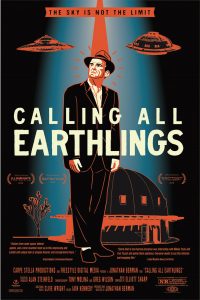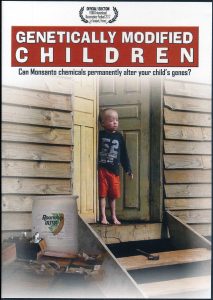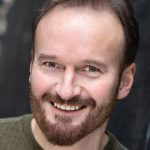by Mark Maxwell Abushady, New York City
FILM
 CALLING ALL EARTHLINGS
CALLING ALL EARTHLINGS
Produced and directed by Jonathan Berman
Music composed by Elliott Sharp;
additional music by Clive Wright
Carpe Stella Productions
callingallearthlingsmovie.com
Calling All Earthlings is an open-minded look into the life and work of George Van Tassel, an aeronautical engineer, ‘Tessla scientist’ and … UFO contactee. It contains all the elements for an intriguing, thought-provoking and entertaining documentary. After what is described as “an exemplary career in aviation” with positions at Douglas Aircraft, Lockheed and Hughes Aircraft (where he worked with Howard Hughes on advanced aircraft), Mr. van Tassel leaves his career behind and moves his wife and daughters to Giant Rock in the Mojave Desert of California. There, after setting up a most unusual home, he starts to lead meditations, channeling “the space people” and delivering messages. “Colorful,” learned, and mystical characters on all sides of the controversies are interviewed. Selections from FBI reports on van Tassel and the concern of “communist activities” are also presented.
But George van Tassel was more than a passive channel to “the space people.” He was intrigued by Nicola Tessla’s exploration of ways to harness free electric currents and set about working with the concept. In the course of eighteen years he built, through his own money, donations and volunteer labor, the Integratron – a structure without nails or screws – “meticulously built based on principles of sacred geometry.” Metal rods on the outside of the round structure were to spin and create a 50 megavolt electromagnetic field, with the created electrostatic field brought into the building by wires. By passing through this field, van Tassel believed that one’s lifespan could be extended by 20 to 50 years or more.
By extension, the documentary touches upon the concept of visiting space people, the likelihood of such visits, the character and mysticism of religions that rise out of desert environments, and conspiracy theories around folks who disappear, or die, when they are on a course of study which threatens to cut profits to multinational corporations. George van Tassel died of a heart attack at 65 years of age, before his Integratron could be turned on. It was ransacked and all notes and calculations were removed. Van Tassel said of the “space people”: “They are out there. I can talk to them, they can talk to me, and you can talk with them too.” The comment is made that when technology is devoid of heart, great harm happens. This was of concern to van Tassel, and, of course, has been an ongoing theme to this day in many of our ethical grapplings with an ever-advancing science and the capabilities it has spawned. George van Tassel was clearly a fascinating man and this documentary telling of his story feels long overdue.
 GENETICALLY MODIFIED CHILDREN
GENETICALLY MODIFIED CHILDREN
A film by Juliette Igier and Stéphanie LeBrun
Cinema Libre Studio
www.GMChildren.com
In 1996 the Argentinian government authorized the use of genetically modified seeds and the associated chemicals based upon studies done by Monsanto itself. Today, over 300 million liters of Glyphosate are used on Argentinian soil every year. Phillip Morris provides the genetically modified seeds of the tobacco, the cultivation of which requires approximately 100 chemicals. Subtitled Can Monsanto chemicals permanently alter your child’s genes? this film’s title is a bit of a misnomer in that it only relays one small part of the subject matter presented. Actually, the film is about the genetically damaging and teratogenic effects of agrochemicals, the most ubiquitous of which is Monsanto’s Glyphosate (RoundUp). It is also about the ways farmers’ hands are forced by agribusiness to grow plants in a certain way or face the inability to sell their crops. It is about the stranglehold these multi-national corporations (Monsanto, Bayer, Nestle and the like) have upon people and governments, the devastating consequences of under-regulated toxins upon children and their families, and even, by extrapolation, about the sacrifice of the Southern hemisphere for the wants of the Northern.
The film is smartly organized into five parts. After mention is made of the 2015 World Health Organization classification of Roundup as “probably carcinogenic,” we meet several families of farmers in northern Argentina, an area in a country described by the author as having become “a laboratory for agribusiness.” Here, we meet Ricardo Rivero, regional head of the electric company, who sets out to investigate why many families are not paying their bills. He finds an inordinate number of disabled, critically ill, or otherwise compromised children born to families in the region. As their stories unfold, we hear of improper (or no) labeling on the chemicals required to grow their crops to meet “industry standards.” And while commercials play on local television touting the benefits of Roundup, an economy is created such that a farmer’s Social Security, which the farmer needs to care for the sick children, is tied to the growing of tobacco. An inescapable way of life is thus created. These children are saddled with severe, heartbreaking congenital deformities and cognitive issues. In 2010, lawyers and doctors from Mexico and the United States came to research and initiate lawsuits against Monsanto, which included 144 of the families. To date there are no resolutions to report. At one point, before the filming in the chemical distribution barn was stopped, it was clearly seen that workers unpacking and repackaging chemicals had no special attire, masks or headgear.
About halfway through the film we meet local doctors in Posadas; Professor Hugo Gomez Demaio, head of Neurosurgery at the Pediatric Hospital of Posadas, and Professor Mario Barrera, Neurosurgeon and Professor in the Medical School of Nordeste. Both have seen and recorded the ever-increasing number of affected children in the region. In addition to direct exposure to agrochemicals, they cite exposure through the washing of work clothes in the rivers that drinking water is drawn from. Here, the doctors postulate that the genetic damage to the workers in the fields is passed on to the children in their genes. They strongly suggest that the chemicals are held in the adipose cells of the worker, which can migrate to the ovaries or testes of the parents and, in this location, cause genetic damage. They feel the statistics they’ve collected are inescapable, and they have been joined in their investigations by a network of doctors, published in 2009, their findings of miscarriages and congenital defects. These conditions are occurring at six times the rate of the norm, with cancers at five times the average. They share their findings of myelomeningoceles (severe and monstrous lesions of the central nervous system), which, though they can occur naturally, multiply in the presence of agrochemicals. Monsanto contested their report, citing as more accurate their earlier study on animals, rather than a more recent human study (or the observations and statistics of these doctors).
Another region visited is Cordoba, referred to by a resident as “The Realm of the Transgenic Soybean.” Here, Glyphosate is sprayed by plane, and the town is covered in anti-Monsanto graffiti. In yet another segment, “The Mothers of Ituzaingó,” we meet Sofia Gatica, a local mother turned activist, who went door to door in her neighborhood to find out about people’s health problems. Cancer, Leukemia, and malformations were among the issues she discovered. Her own daughter died of a kidney malformation. Regarding Leukemia, all cases occurred in families living close to the soy fields. She found 16 cases in the 5,000 inhabitants (‘normal’ is 1-2 cases in 100,000).
This film is well worth a viewing. In fact, although it is an extremely upsetting subject, it is a wonder to see individuals stand up to, and make progress against, a seemingly unstoppable force propelled by immense profits over decency and humanity. That this is possible is important for all of us to remember, especially as we enter this time in our history where systems are breaking down and everything is being re-examined.
 Mark Maxwell Abushady is an actor, singer, designer and photographer based in New York City. www.markmaxwellabushady.zenfolio.com
Mark Maxwell Abushady is an actor, singer, designer and photographer based in New York City. www.markmaxwellabushady.zenfolio.com












































































































































































































































